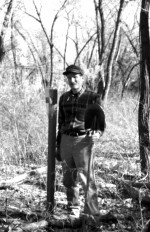The Sevilleta’s Schoolyard LTER Program is known locally as the "Bosque Ecosystem Monitoring Program" (BEMP). Dr. Clifford Crawford (University of New Mexico professor emeritus) established BEMP in 1986 with a $50,000 Informal Science Education grant from the National Science Foundation. Crawford now sustains BEMP with the Schoolyard LTER Supplements.
The Program focuses on the Rio Grande riparian cottonwood forest, or bosque in Spanish, a corridor that bisects New Mexico (including the Sevilleta National Wildlife Refuge) from Colorado to the Mexican border.
"The bosque was a natural selection for BEMP," Crawford says. "It’s so popular and important and it’s very easy to get to for the classes."
BEMP has four main educational goals:
- Involve students and citizen volunteers of all ages in the coordinated monitoring of key processes and populations of the endangered Middle Rio Grande riparian forest ecosystem
- Enable these participants to "learn by doing" about the natural history and ecology of the bosque near their communities;
- Use these students and volunteers to convey to their communities an appreciation of the scientific and social significance of long-term environmental research
- Give the students and informed citizens an opportunity to become involved in the management of a critical environmental resource
Cooperation with the Bosque Preparatory School in Albuquerque makes the Bosque Ecological Monitoring Project possible. Photo courtesy Cliff Crawford.
The Program involves mainly secondary school teachers and their students, who collect data relevant to the long-term management of bosque functioning. Participants collect data synchronously and according to a predetermined schedule, sampling a given set of variables on the same date at all four current BEMP sites.
The sites are identical in layout and located between northern Albuquerque and the city of Belen, just north of the Sevilleta NWR.
Site-specific abiotic data collected include soil and air temperature, precipitation and groundwater depth. Biotic data include litter production, plant diversity and indicator arthropod activity. Years of restoration-related research on the bosque has demonstrated the value of such data types and the relative ease of collecting them in the field. Over the years, BEMP has contributed substantially to the database, which has been utilized in inter-agency projects concerning the future of the Middle Rio Grande Valley.
In addition to Crawford, two coordinators and a data manager staff the Program. The coordinators are biologists and educators associated with Bosque Preparatory School in Albuquerque, which pays the release-time salary of one of them. UNM undergraduate students working as interns have recently become an essential part of the BEMP.
The 1998 Schoolyard supplement made it possible to award stipends to two of the most experienced interns. Another intern has an Undergraduate Mentorship Experience in Environmental Biology stipend awarded through the Sevilleta LTER.
Each BEMP intern is assigned to work with site representatives (usually secondary school teachers) and individuals (usually their students) who collect the monitoring data following a brief period of training. Interns are responsible for supervising data sampling and for bringing sample material and field data records to UNM, where some additional sample treatment is performed by specially trained interns.
Los Lunas High School participants measure growndwater depth at the Los Lunas Bosque Ecological Monitoring Project site. Photo courtesy Cliff Crawford.
The data manager then enters the data in a UNIX system operated by the Sevilleta LTER. Following data analysis, the data manager, in consultation with the director, will disseminate pertinent results to school classes, as well as government agencies that have managerial responsibility for the bosque and the Rio Grande; hence, the data from the Schoolyard LTER program actually is applied to real-world management issues.
In addition to continuing the existing program, another goal for the current supplement is to finish the development of the databases and the Web site, so that teachers, students, and the public can easily access the data sets as they develop. The BEMP data sets are currently being entered and archived on the Sevilleta LTER Web site, and should be completed during the coming year.

 Enlarge this image
Enlarge this image
